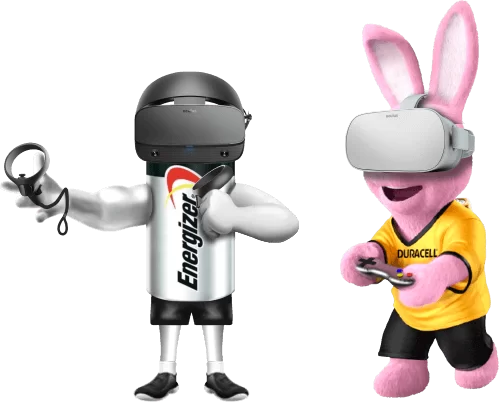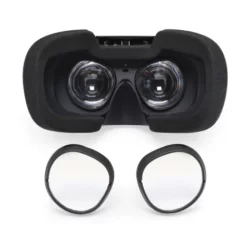

What's the best battery for VR controllers?. There are so many different brands of battery, so which should you choose? Eneloop by Panasonic is the next generation battery, one that is kind to the environment. The batteries are becoming more and more popular and are now sold in over 80 countries around the world.
VR NewsWhat's the best battery for VR controllers?. There are so many different brands of battery, so which should you choose? Eneloop by Panasonic is the next generation battery, one that is kind to the environment. The batteries are becoming more and more popular and are now sold in over 80 countries around the world.

Tired of your batteries going down on you when you're fully immersed in a game? Or, for that matter, just when you're about to reach that pinnacle point! Try as you might to ignore the lag and jitter of movement - like a pirate with a broken wooden leg - not to mention aimlessly swinging your hook in the air or firing willy-nilly into no man's land, it's just not right, why? Why now? And don't even think about looking in the man cupboard for those empty batteries you put back there - as if you'd ever think of using them again anyway! Calm down, sit back and have a good read while I explain a little information about batteries and the right ones to use in your controllers. Never get sucked dry again! Get some decent juice in your controllers. Let's take a look at the best AA and AAA batteries that won’t leave you out of charge.

Which battery is best?
There are so many different brands of battery, with top brands powering most of our cordless phone handsets, TV remotes, children’s toys and more importantly our VR controllers! These items are more likely to take AA or AAA batteries than any other size. Some of the biggest selling consumer batteries are Duracell and Energizer. It’s not necessarily because they’re the best either, it’s because they are everywhere, you can’t hide from them. If we really want to know which battery is the best, we need to look a little deeper.
Duracell, Energizer and other brands appear everywhere from gas stations to candy shops, not to mention heavily televised on our TV's - the pink bunny rabbit and the hyperactive battery man immediately spring to mind. Brand plays an important part in our everyday shopping decision-making, and it's no different when it comes to batteries. When it comes to battery price, should that be a factor in the decision? Buy because it's cheap? Or buy because it's expensive - so it must be good, right? Well, yes and no!

Zinc chloride batteries used to be the popular battery of choice. They’re still dirt cheap, and you can still buy them, although you don't see them around much anymore. These batteries are fine for low-drain gadgets such as a TV remote control, but they won't last long on anything more demanding, like our VR game controller, certainly for those controllers such as the HP Reverb G2 and the Vive Cosmos, as these use LEDs in order to track the headset and controllers. If you're the proud owner of the Oculus Quest 2, you shouldn't have to worry too much about the power-drain, they last for ages with the new controllers.
Alkaline batteries are the mainstream battery of choice for high-drain devices. The prices are also very reasonable; a 100 pack of Amazon Basics - AA Performance batteries will only set you back £20... Wow! 20p each! Now that is cheap! Currently, alkaline batteries are the most popular type of disposable battery on the market. They are easy to find and easily outlast the older zinc chloride batteries. Nonetheless, while an alkaline battery is a primary battery originally intended for disposal after a single use, modern battery technologies have allowed the evolution of rechargeable alternatives.
More expensive battery brands, like Duracell and Energizer, can contain up to three times as much battery power as a cheaper one, are less prone to leaking, and tend to last longer when stored. When it comes to buying batteries, the majority of people choose a branded battery that is familiar to them. Overall, popular branded batteries outperform and outlast any bargain bin batteries you may pick up in your local petrol station or corner shop.
There are four types of rechargeable batteries available on the market today:
Nickel Metal Hydride (NiMH): The top selling rechargeable battery and available in all the common sizes; AA, AAA, C, D and square type, 9v rechargeable batteries.
Lithium Ion (Li-ion): You're probably sitting close by to one right now, as they're used to power most mobile phones and digital cameras. These lithium batteries work even better than alkalines. They last much longer and have an amazing shelf life. Sadly, these aren’t available as consumer size rechargeable batteries.
Lithium Polymer (Li-pol): batteries are usually designed as custom fitted battery cells. Most chargeable VR controllers use Lithium Polymer cells, such as the HTC Vive and Vive Pro, both of which utilise 960 mAh battery cell and the Valve index, a 900 mA fast charging, 1100 mAh Lithium Polymer battery, lasting an incredible 7 hrs +.

Sealed Lead Acid (SLA): I won't go into too much detail here, I'll just touch on what it is and where it's used. These batteries are generally very large and robust and are commonly used for emergency power in commercial alarm and lighting systems and data centres. You won't fit one of these in your game controller, that's for sure!
Finally, a note of caution. Please stay clear of rechargeable Nickel Cadmium (NiCd) batteries if you come across them. They will be cheap, but that’s because they’re all unsold stock, hanging around since they were withdrawn from sale in the EU. Because of environmental regulations, NiCd is limited to specialty applications today and has been replaced by Nickel Metal Hydride.
Rechargeable batteries, such as Nickel Metal Hydride (NiMH), do not hold a charge for as long as a single use alkaline battery. Alkaline batteries can be left in your draw for years at a time. NiMH batteries start to lose power when stored for only a few days at room temperature and gradually lose most of their charge in around thirty days, but will retain a 90% charge for several months if you keep them in the freezer after they are fully charged. You should let them return to room temperature before using them. Another thing to point out, if you decide on using NiMH batteries with your controllers and you're prompted that your battery is low, it's time to change the batteries now! NiMH is not as forgiving as Alkaline batteries when the power gets low.

Alkaline batteries are relatively cheap, while the up-front cost of a rechargeable battery is seven times more expensive than a single use battery! Over a rechargeable battery’s lifespan, however, single use batteries can work out as up to TWO HUNDRED TIMES more expensive – worth thinking about.
Alkaline batteries are cheap as chips, while the up-front cost of a rechargeable battery is roughly seven times more expensive. Over a rechargeable battery’s lifespan, however, single use batteries would be over 200 times more expensive. So... are rechargeable batteries better value? Yes.
For batteries used for controllers as well as handheld controllers for the Xbox and PS5, we highly recommended the EBL charger, and the eneloop pro battery batteries as a set combo. Both are available to buy on Amazon and, although the batteries are expensive, the charger should last you for years to come.
Eneloop by Panasonic is the next generation battery, one that is kind to the environment. The batteries are becoming more and more popular and are now sold in over 80 countries around the world. The Eneloop Pro range has a minimum 2500mAh (AA), and a maximum 2550mAh (AA) per battery, and can be charged up to 500 times, now that is impressive! The AAA batteries carry 930mAh. On average, families use around 70 batteries per year. By switching to Eneloop, a single charger makes it possible to charge a year’s worth of batteries. The Ni-MH Eneloop Pro range is recommended for use in DECT phones (170 hours), wireless devices (80 hours), radio control cars (3 hours) and DSLR Flash (1.8 hours). These batteries are high capacity and are therefore most suitable for devices that have medium to high power requirements. Amazingly, the Eneloop Pro batteries should still have up to 85% remaining capacity even after a full year without use! All Eneloop batteries are pre-loaded with solar energy and ready for use immediately after purchase. Note: These batteries are intended to be used in high drain devices and work perfectly well with many handheld VR controllers.
These are the best rechargeable AAs for most people’s needs. Just know that the Eneloop Pros cost a lot - almost twice as much as AmazonBasics or Energizer rechargeable batteries.
We were originally huge fans of Duracell and Energizer rechargeable batteries, until we did a little research and read up on some battery tech, eventually stumbling on the Panasonic Eneloop batteries. After reading the reviews I decided to take the plunge and order some to try out in our VR controllers, mainly to see what all the hype was about and more importantly see how long they actually lasted.
I must say, we were all impressed with just how long the batteries lasted even when being left untouched for a few months. They still had plenty of charge and still performed very well in the controllers.
Have you got a favourite battery that you use in your controller? Why not tell us a little more about it in the comment box below...



